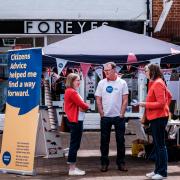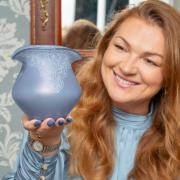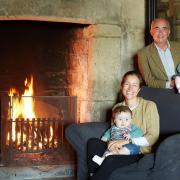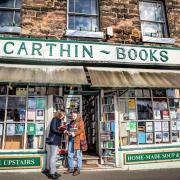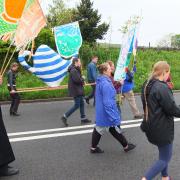Smalley resident Jan Walker MBE died on June 25, aged 91.
We met only once, in 2009, but, in a sense, she’s been a part of my life since 2012, the year I began presenting My Derbyshire Life, a talk chronicling my 15 years (2004-2019) of writing monthly articles about towns and villages.
It’s also fitting I make this more than a tribute. The reason Jan features in my talk is that in 2007 she was awarded an MBE for services to the community.
As I show photos of Jan, I point out Smalley has long been a very community-minded village, largely due to the ‘Queen of Smalley’ having spent so many years as chairman of the Parish Council and being involved in countless other local organisations and societies.
I remember my Derbyshire Life interview with Jan was continually punctuated by both telephone and front door ringings. She was clearly a woman in demand.
Jan dealt with all swiftly, efficiently and politely. It was both impressive and mesmerising, akin to watching a magician spinning plates.

So, when Jan’s ‘reign’ ended, it made me ponder her legacy. Will her passing galvanise or demoralise the village?
Also, as my Smalley article was published 15 years ago, it presents a wider question: is community spirit in rural Derbyshire as strong as it once was?
That poser was actually addressed in my 2009 feature, through reproducing a beautifully crafted poem by Colin Pritchard of the Smalley Poetry Group.
His pertinent verse initially appears as a nostalgic paean to rural life but is then revealed as a heartfelt plea, largely to village dormitory dwellers:
Villages; we know the names
Glimpsed from passing roadside signs,
Captioned in some magazines
Or Sepia prints of sleepier times
Clustered roofs of angled tiles
Frame old nooks and crannied streets
Green lined ponds where all roads meet
To greet some church’s soaring spire.
But what purpose do these idylls fill
When farm nor pit nor mill no longer give
Reason other than a place to live?
Who maintains the fabric of this life?
Of local bonds or history most are free,
No longer bred of neighboured stock.
So who now winds the village clock
That stands, now still, at ten to three?

As his lines imply, every rural community needs a Jan Walker, someone who ‘maintains the fabric of this life’ and ‘winds the village clock’.
What largely prompted Colin’s poem was that when he last encountered Jan, this septuagenarian had just been rodding out the church hall drains.
Previously, Colin saw Jan sitting on an upturned bucket painting Smalley’s surviving cast iron milestone, arguing ‘it would take the council six months to get this done, so I'm doing it!’
This can-do attitude came at an early age. Addressing a packed-to-overflowing congregation at Jan’s funeral in St John’s, her eldest daughter Elisabeth Cragg told us a young Jan wasn’t academic but had ‘bags of common sense and a drive to do things.’
This was exemplified by her early passion for aeroplanes: she accomplished her first solo flight (at Burnaston) just short of her 18th birthday.
Jan was brought up at Radbourne Hall (her father ran a prosperous butchery business on Sadlergate) and, when she married Jim in 1956, moved to Stainsby Lodge in Smalley, where she worked as a hairdresser and gradually immersed herself in the life of the village, especially the church.
At St John the Baptist’s she was, at various times, church warden, Sunday School leader, lay reader and Parochial Church Council member. She also officiated at funerals and organised the annual Church Fete.

Jan also ran the village hall, was branch leader of the Mother’s Union, president of the Inner Wheel in Heanor, and a member of the Young Wives Group, Conservative Association and Red Cross.
She was on at least a dozen committees, raised money for charities, and delivered Meals on Wheels for 40 years.
Dorothy Allsop recalls a time she rang Jan only for Jim to answer. ‘Is Jan in?’ she asked. ‘What do you think?’ replied Jim.
‘She was on the Parish Council for 57 years’ points out Parish Council chair Martin Gallimore, ‘in all that time, she only missed three meetings, one of which was the week she passed.’
She was a formidable presence as a councillor, too, often heard to say at meetings: ‘Let’s stop talking about it; let’s do it!’
According to Geoffrey Marshall, a dear friend of Jan’s when acting part-time vicar of Smalley and Morley from 2016: ‘Jan was very good at persuading people to do things, then she’d often stand over them to make sure the job was done the way she’d have done it. If you agreed to do something, she was surprised if it wasn’t done immediately!’
However, Geoffrey adds that when the job was done, Jan was generous with her thanks. Dorothy Allsop showed me a cherished letter of thanks sent in 1969 after Dorothy organised the first flower festival at the church.
‘We were near neighbours, so Jan could have telephoned or called round’ says Dorothy, ‘thanking me in writing for “the beauty of your arrangements” made me feel more valued.’
The Rev Kate Plant, the priest at St John’s who conducted Jan’s funeral, has special memories of Jan: ‘I shall cherish her countless acts of kindness, so many of which others didn’t know about. I’ll also remember that she understood God, and it was her love of God that drove her love for her neighbour.
‘It wasn’t just what Jan did: it was what people around her found themselves doing. She persuaded a non-churchgoing newcomer to Smalley to become the church treasurer. She saw something in him. Five years on, he’s still battling away with our finances. Jan encouraged us all to go the extra mile.’
Many funeral-goers recounted fond memories, describing Jan as ‘elegant’, ‘highly respected’, ‘a powerhouse’ and ‘a force of nature.’
Richard and Linda Kirby had a remarkable recollection which proves Jan was active well into her later years.
‘In 2017, we arrived in church and told Jan how difficult it was walking up the lane into the village because of overhanging trees and twigs. The following Sunday, the lane had been cleared. By Jan. She was 84.’
Speaking to Derbyshire Life in 2009, Jan had concerns about the community spirit she had herself inspired in Smalley: ‘At this church alone, we have a flower festival, memorial services, baptisms, garden parties, winter fairs, plant sales, harvest suppers and New Year luncheons. They all add to community life.
‘Yet the 20 or so folk who presently and latterly lay on these events do sometimes wonder who will do the work and give the time and energy in a few years’ time. Also, insurance, health and safety rules and a nanny state have taken the edge off voluntary service. I constantly come across community-minded residents, people who look to care for their neighbour but there are far too many who hardly know they have a neighbour.’
With this cherished neighbour now gone, who will keep that village clock wound? Parish Council chair Martin feels some disquiet: ‘I’m sad to say community spirit is sorely lacking, but I don’t believe it’s just in Smalley. I think it’s a national problem that communities don’t pull together anymore.
‘The older residents still seem to have camaraderie but few of the younger generation have the community spirit past generations are known for.’
A more optimistic outlook is voiced by Anne Jobling, secretary of the Smalley Community Group, set up in 2016 with a mission ‘to bring together all parts of the community.’
In the last eight years this group has organised numerous events including a community café, annual community picnic, scarecrow festival and music nights.
‘Our group committee tends to be made up of older residents,’ admits Anne, ‘but that’s because older people have more time for volunteering. We’re not all retirees - our chair is young with a young family - our events are attended by large numbers including many young families.’
So, this would indicate a positive future for Smalley, thanks to the community group. But what about the church? Will it be the poorer following Jan’s passing?
‘No,’ insists Kate Plant, ‘the church won’t be less without Jan as she helped us discover new strength and purpose, and we have that still. Many love what is good in Smalley, and though communities evolve and change, the spirit Jan channelled, remains.’
‘Village life often depends on one leader’ points out Geoffrey Marshall. ‘When that leader moves away or dies, it’s easy for village life to die, too. I don’t think that will happen in Smalley. Because the villagers and churchgoers will sorely miss all Jan did, and know what Jan did, it’s my hope Smalley will find more than one person to fill her enormous shoes.’




